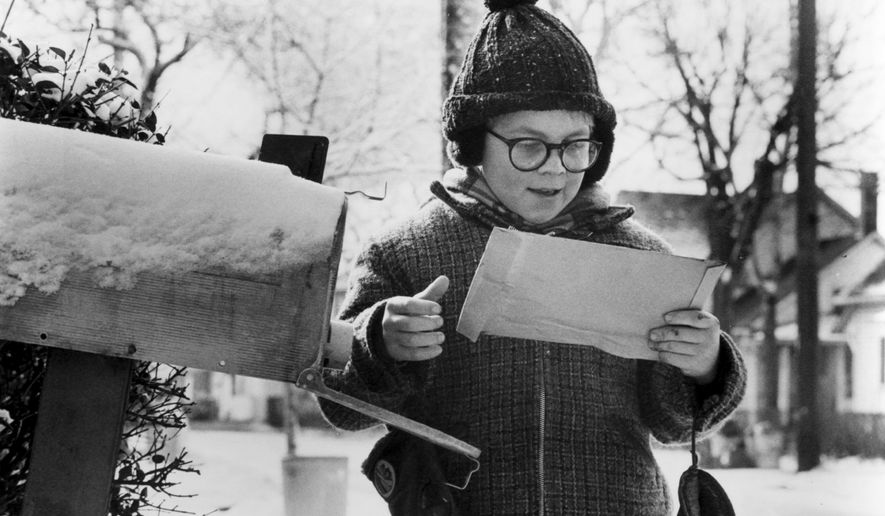It’s hard to separate the character of George Bailey in “It’s A Wonderful Life” from his daughter, ZuZu.
The moment in the 1946 classic when James Stewart’s Bailey pulls the petals of ZuZu’s flower from his pocket and runs home to the arms of his family has, for many Americans, become a big part of the yuletide season.
Stewart’s Bailey stands in strong contrast to another patriarch of a classic holiday film, Darren McGavin as Old Man Parker in 1983’s “A Christmas Story.”
Foul-mouthed, disgruntled and quick to anger, Parker plays the buffoon of the family in many of the film’s signature jokes, like his obsession with a lamp shaped like a woman’s leg.
The progression from Bailey to Parker isn’t just an example of film portrayals of families changing, it’s a reflection of the changing way Americans think about family, says family and relationship counselor Dana Corey.
“The whole concept of family has shifted for us,” Corey said. “Humans have to make everything mean something, and most of the time the meaning we ascribe is negative. It’s the same with (movies and families).”
Different families
Marriage and family therapist Lisa Bahar says current holiday-movie families stem from our reaction to one word: Normal.
“More often than not, families have their own ways of interacting and there tends to be a perception that my family’s not normal (when compared to an idealized version in old holiday films),” Bahar said. “There’s no way of defining what’s normal. So movies are portraying families so that people can relate to them.”
One of the driving factors changing Americans’ ideas about family is marriage, says Ohio State University family studies professor Claire Kamp Dush.
“Marriage is based on personal satisfaction rather than efficiency,” Kamp Dush said. “Marriage now is about maximizing your own benefits from the relationships, and when they’re not there, you leave it.”
Corey agreed, pointing out that families just a few generations ago were about necessity and obligation rather than love and happiness.
“If you think about the Great Depression forward, family was important because they were the ones you could count on,” Corey said. “Whether you got along or not, it benefited you to stick together and help each other.”
With a 40-50 percent divorce rate in the U.S. comes new family structures that can make family time harder to manage, which accounts for holiday movies like “Four Christmases” or “The Santa Clause,” which center around broken families and dividing time fairly among the multiple families that can grow out of divorce.
But Corey says divorce isn’t the only factor changing ideas about family. She said that attitudes about family change with different stages of life.
“There comes this point where if you’re an adult and not living close to family and you don’t have family of your own yet, that’s when ideas about family get really amorphous,” Corey said. “Can you afford to go home? Do you want to do that with your vacation? The choices you have to make shift based on where you are in life.”
And in those intervening years when family is lower on the priority list, Corey says more people fill their need for family connection by creating families out of friends and co-workers — connections that can be just as strong as any bloodline.
“We want that connection that we think of when we think of family,” Corey said. “So we create a family of our choosing.”
Dysfunctional reality
A hallmark of families in many modern holiday movies is dysfunction — and often that dysfunction is worn as a comedic badge of honor.
Take 2004’s “The Family Stone,” about a woman (Sarah Jessica Parker) who struggles to be accepted by her boyfriend’s mother (Diane Keaton) over Christmas as the family deals with the mother’s cancer diagnosis.
“What’s so great about you guys?” Parker’s character sobs at one point.
“Nothing!” Keaton’s character says. “It’s just that we’re all we’ve got.”
Yet even those “idealized” versions of families crystallized in the holiday consciousness were far from perfect.
In “It’s A Wonderful Life,” George Bailey contemplates suicide on Christmas Eve.
Susan Walker from “Miracle on 34th Street” is raised in a single-parent household — uncommon in 1947 terms.
And Christmas is ruined for the Smith girls in “Meet Me in St. Louis” when their father announces they will be uprooted from their relationships and educations to move to New York City.
“It never was like that,” Corey said of the holiday “idealized” family. “It’s like the difference between a functional alcoholic and a non-functioning alcoholic: Families have varying degrees of dysfunction, but it’s very, very few that don’t have some form of dysfunction.”
While the dysfunction might not be new, Kamp Dush says the way audiences and movies look at it is.
“(Family) probably is hectic and crazy and it can be dramatic, but it’s probably not quite at the level that’s being exaggerated on film. That’s what makes movies fun,” Kamp Dush said. “The difference is, these days we’re just laughing at it instead of pretending everything is fine.”
Bahar said that seeing family dysfunction played out on screen makes people more comfortable with their own feelings about family.
“Movies illustrate that families aren’t always so perfect. People can relate to that in a way that validates them,” Bahar said. “It’s a story everyone can relate to.”
Being able to laugh at the things that upset people the most is one of the healthiest things that can happen, Corey says.
“Sometimes life just sucks. If you can’t laugh at it, then it’s 100 times worse,” Corey said. “If you can laugh at it, there’s hope.”




Please read our comment policy before commenting.